St John's, Edinburgh
The Church of St John the Evangelist is a Scottish Episcopal church in the centre of Edinburgh, Scotland. It is sited at the west end of Princes Street at its junction with Lothian Road, and is protected as a category A listed building.[1]
| St John's Church | |
|---|---|
| The Parish Church of Saint John the Evangelist | |
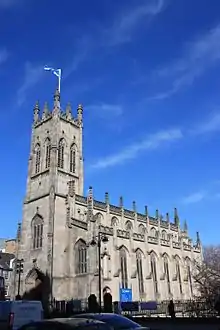 | |
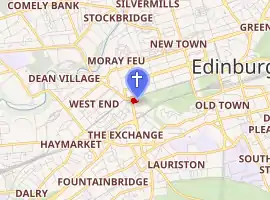
| |
| Location | Edinburgh |
| Country | Scotland |
| Denomination | Scottish Episcopal Church |
| Website | Website of the church |
| History | |
| Status | Active |
| Dedication | John the Evangelist |
| Dedicated | 19 March 1818 |
| Architecture | |
| Functional status | Parish church |
| Architect(s) | William Burn |
| Architectural type | Neo-gothic |
| Groundbreaking | 1816 |
| Administration | |
| Diocese | Edinburgh |
| Clergy | |
| Bishop(s) | John Armes |
| Rector | Markus Dünzkofer |
Background
The church was dedicated as St John's Chapel on Maundy Thursday 1818 with construction having begun in 1816. It was designed by the architect William Burn[2] the previous year, at the age of only 25.
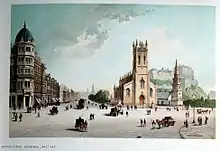
The congregation had begun in 1792 when Daniel Sandford came to Edinburgh to minister on Church of England lines. In 1797 the Qualified congregation moved to Charlotte Chapel which was re-built on larger lines in 1811. They sold shares to fund a new church, the banker Sir William Forbes being the main figure, and Charlotte Chapel was then sold to the Baptists.
Edward Bannerman Ramsay joined St John's as curate in 1827. He succeeded Bishop Sandford as minister in 1830, and stayed until his own death in 1872, having being Dean from 1846.
The sanctuary and chancel were built in 1879–82 by Peddie & Kinnear (John Dick Peddie and Charles Kinnear). The vestry and Hall were added in 1915–16 by John More Dick Peddie and Forbes Smith.
The war memorial was added in 1919 to a design by Sir Robert Lorimer. Lorimer also designed and oversaw the addition of faux-vaults when Lothian Road was widened in 1926.[3]
St John's holds daily services and is unique in that it is the last remaining Episcopal church in Scotland to hold the weekly service of Matins.
Description
.jpg.webp)
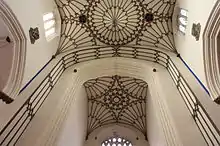

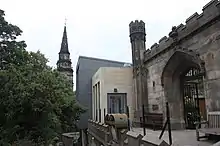
The plaster ceiling vault is derived from that found in the Henry VII Chapel in Westminster Abbey.
Stained glass is largely by Ballantine, but the east window is by William Raphael Eginton.[4]
The morning chapel was furnished by Walker Todd in 1935.
An extension was added to the south-east corner in 2018.
List of rectors
- 1804–1830: Daniel Sandford
- 1830–1872: Edward Bannerman Ramsay
- 1873–1883: Daniel Fox Sandford
- 1883–1909: George James Cowley-Brown
- 1909–1919: George Frederick Terry
- 1919–1926: James Geoffrey Gordon
- 1927–1939: Charles Henry Ritchie
- 1940–1947: Sidney Harvie-Clark
- 1947–1961: David Brownfield Porter
- 1962–1969: Keith Appleby Arnold
- 1969–1981: Aeneas Mackintosh
- 1982–1997: Neville Chamberlain
- 1998–2012: John Andrew Armes
- 2013–date: Markus Dünzkofer (instituted 11/02/2013)
Memorials
- General Sir John Campbell, 2nd Baronet of New Brunswick, Canada
- Sir Henry Raeburn
- Dean Edward Bannerman Ramsay (a tall granite Celtic cross by Robert Rowand Anderson of 1878 with Celtic bronze reliefs by Skidmore, facing Princes Street just east of the church)
- John Stuart Stuart-Forbes (1849–1876) (also known as J. S. Hiley; died at the Battle of the Little Bighorn in North America. His plaque can be found on the left hand side of the church as you enter) The plaque reads "In Memory of John Stuart Stuart Forbes 7th Regt. United States Cavalry. Born at Rugby 28th May 1849. Killed in Action 25th June 1876."[5]
Graveyard
- Rev Archibald Alison and his son William Pulteney Alison
- Sir William Arbuthnot, 1st Baronet
- Lesley Baillie (1768–1843) subject of Robert Burns' poem "Bonnie Lesley"
- Thomas Balfour (1810–1838), MP for Orkney and Shetland
- George Joseph Bell (1770–1843), legal author
- George Burnett, Lord Lyon (1822-1890)
- General Sir Archibald Campbell, 1st Baronet (1769–1843)
- William Campbell, Lord Skerrington (1855–1927), Senator of the College of Justice 1908-9
- Major General Nicholas Carnegie of Coates (d.1824)
- Sir James Clerk of Penicuik (1812–1870)
- James Donaldson (1751–1830), founder of Donaldson's School for the Deaf
- Andrew Duncan (1773–1832)
- Daniel Ellis (botanist) (1772–1841)
- William Erskine (1773-1852) historian
- Sir Hugh Bates Maxwell and Sir William Maxwell, 9th and 10th Baronets of Calderwood (within the eastern enclosure)
- Sir William Forbes's son George Forbes (died 1857)
- Prof Sir William Hamilton, 9th Baronet (1788–1856), metaphysician (stone moved and used as edge paving in the eastern enclosure)
- Thomas Kinnear (1796-1830) banker
- Prof Thomas Laycock (physiologist) (1812–1874)
- James Skene (d.1864) and his son William Forbes Skene (1805-1892) buried under the chapel[6]
- Aeneas MacBean (1778-1857) rich lawyer
- Aeneas James George Mackay (1839-1911)
- Charles Kincaid Mackenzie, Lord Mackenzie (d.1938)
- General Anthony MacRae (1812–1868), with bronze by Sir John Steell
- George Moir (1800–1870), lawyer and essayist
- John Shank More (1784–1861)
- Macvey Napier (1776–1847)
- Margaret Outram (1778–1863), widow of Benjamin Outram
- Bouverie Francis Primrose (1813-1898)
- Anne (1793-1825), sister of Stamford Raffles
- Dean Edward Bannerman Ramsay (buried distant from the memorial on Princes Street (see above) with a separate monument) and his brother Admiral Sir William Ramsay (1796-1871)
- Bishop Harry Reid (died 1943)
- Sir James Milles Riddell, 2nd Baronet (1787-1861)
- Anne Rutherford (mother of Sir Walter Scott)
- Daniel Fox Sandford (1831–1906), Bishop of Tasmania, son of Daniel Sandford (bishop of Edinburgh), founder of the church.
- Catherine Sinclair (1800–1864), author
- Sir John James Stuart of Allanbank (1779-1849)
- Prof James Syme (1799–1870), surgeon
- Peter Guthrie Tait (1831-1901) and his sons John Guthrie Tait (1861-1945) and William Archer Porter Tait (1866-1929) plua a memorial to Frederick Guthrie Tait (buried in South Africa)
- William John Thomson RSA (1771–1845), American-born artist, member of the Royal Scottish Academy
- James Walker (1781–1862), civil engineer
- Bishop James Walker (1770–1841)
- Sir William Stuart Walker (1813-1896)
- George Young, Lord Young (1819–1907)
- Malvina Wells (1804-1887) only known person buried in Edinburgh who was born a slave.
Edinburgh City Centre Churches Together
St John's is one of three churches which form Together, an ecumenical grouping in the New Town of Edinburgh. The others are St Andrew's & St George's West and St Cuthbert's.[7]
Just Festival
The church is also home to Just Festival (formerly known as the Festival of Spirituality and Peace) which takes place each August alongside the Edinburgh Festival Fringe.
Tabot
An Ethiopian tabot, discovered in storage at St John's Church, was returned in February 2002 to Addis Ababa.[8][9]
Same-Sex Marriage
in 2017, the Scottish Episcopal Church changed its marriage canon to allow for clergy with the consent of their congregations to opt into the Scottish same-sex marriage legislation. The first marriage of couple of the same gender inside an Anglican Church in the British Isles was solemnised at St John's in September of that year, the Rector presiding.[10]
References
- Historic Environment Scotland. "Lothian Road, St John's Church (Episcopal)... (Category A Listed Building) (LB27401)". Retrieved 18 March 2019.
- Memorials of the church of St. John the evangelist, Princes street, Edinburgh. George Frederick Terry. 1918
- Dictionary of Scottish Architects: Robert Lorimer
- Buildings of Scotland: Edinburgh, by Gifford McWilliam and Walker
- "The Scots Who Fought With Custer". Scotland Correspondent. Retrieved 18 October 2019.
- https://www.findagrave.com/memorial/146727778/jane-skene
- Together Trust Archived 22 January 2014 at the Wayback Machine
- "Ethiopian joy as church returns Ark of Covenant; Handover may" by Jenifer Johnston, The Sunday Herald, January 27, 2002 (hosted by Find Articles)
- "Ethiopia: Returning a Tabot" by Odhiambo Okite, Christianity Today, 22 April 2002
- "First same-sex Anglican church wedding takes place in Edinburgh" "BBC", 29 September 2017